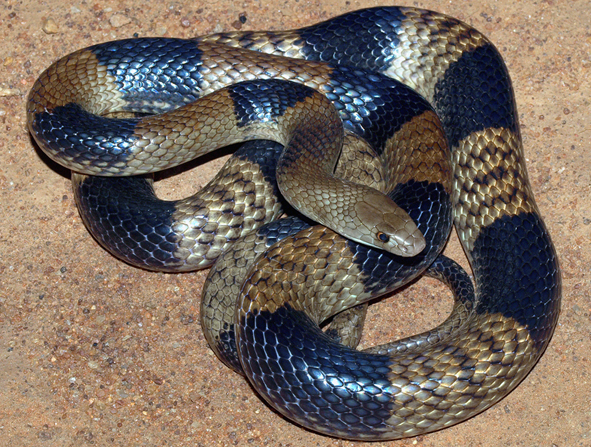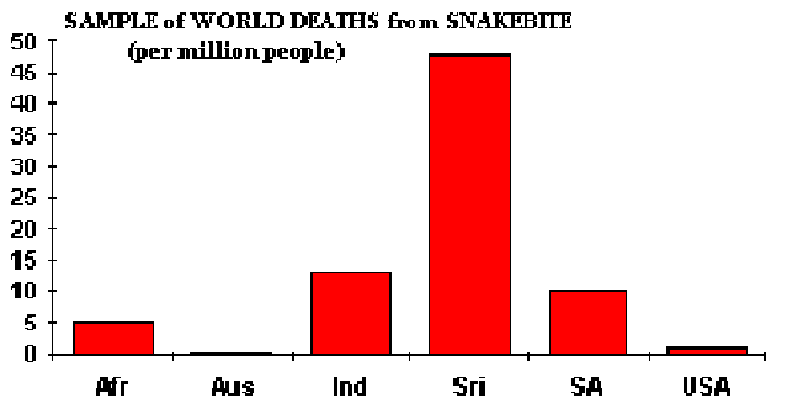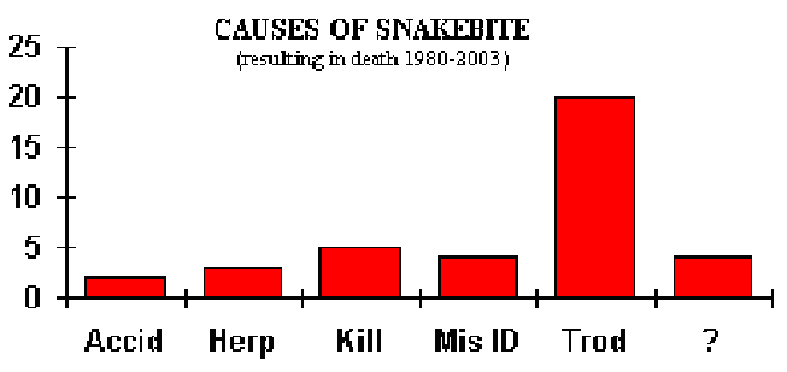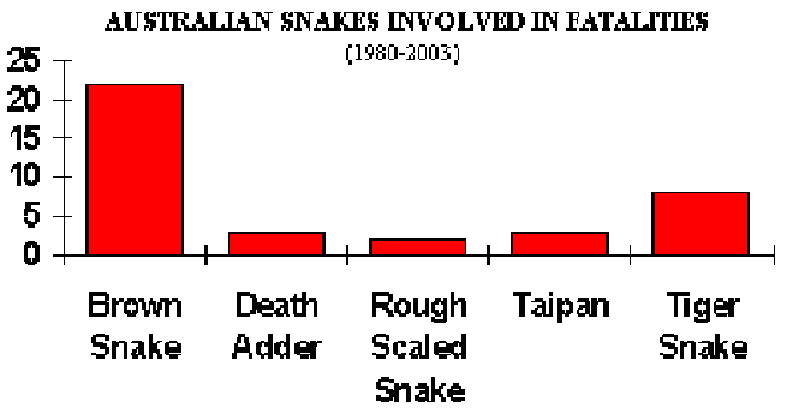Snakes Harmful and Harmless®
Australia's Venomous Snakes: The Modern Myth or Are You A Man Or A Mouse?

by Brian Bush
Author's Note: When concerning reptiles, the terms poisonous and venomous require redefining.
Poison is toxic if inhaled or ingested. The only poisonous reptiles known in Australia are the Green Turtle (possibly) and the Hawksbill Turtle (definitely). The poison, named chelonitoxin, causes similar symptoms to ciguatera poisoning. More people have probably died on this earth as a result of consuming turtle flesh than ever has been the case from snakebite in Australia. There are no reported deaths from turtle poisoning here since 1945.
Venom is generally harmless if ingested but toxic when it comes in contact with the underlying tissue normally protected by the skin. Venomous animals have to break the skin with body-spines, stings or teeth (includes fangs in spiders and centipedes). The only venomous reptiles found in Australia are snakes.
For too long we have been telling the world, as well as each other, that Australia's snakes are the most venomous. On what evidence do we make this assumption? Solely on their ability to kill mice! What a joke!
The basis for the following discussion and points of view are personal experience, comments heard and questions asked during my time lecturing on venomous animals as well as a perusal of the relevant literature. I might just mention here that I have never lectured to mice!
I have heard it said many times by people I believe should know better that this or that Australian snake is "more deadly", "more toxic" or "more venomous" than the Indian Cobra (Naja naja). This is a misrepresentation of the facts and gains little support from the evidence available concerning humans. These types of statements have no place in education if positive results are the goal. All venomous snakes have the potential to be dangerous because of the variable sensitivity between individual people to venoms. However, first a bite has to occur.
Australian snakes are inoffensive and very shy. They have had only forty thousand odd years of human predation to contend with. None of their behaviour has evolved targeting humans. The traditional Aboriginal people only harvested the "quiet" nonvenomous snakes, rarely were the "cheeky" venomous species taken. Maybe this is why it is almost impossible to accidentally get bitten by one unless you run around the scrub in bare feet with your eyes shut, and half full on alcohol.
On other continents humans have existed for hundreds of thousands of years. Therefore, has the cobra evolved the hood, elevated stance and, in some species, the ability to "spit" venom as a direct response to human predation? What about the snakes that play dead? The Rinkhals (Hemachatus haemachatus), one of a few "cobras" capable of spitting, also plays dead. This behaviour would have little effect in deterring a predator looking for a feed, but it may deter a passing human from taking up a club and clobbering the snake into lifeless pulp.
There is a widespread misconception that our snakes are very dangerous animals. Many of us do little to dispel this belief, maybe because we like to believe that Australia's snakes are the most dangerous. This is definitely the modern myth!
In the past 40 years I have met many people who believe tiger snakes have chased them. However, I have yet to meet someone that has been caught by one!
I often publicly comment that Australia's snakes are the deadliest in the world if you are a mouse. This is an objective statement supported by the available data. See Figure 1 for a true appraisal of which country/continent has the deadliest snakes.
Anyone perusing the literature will have seen reference to the LD50 using mice to measure relative toxicities of various snake venoms. This is great data if you are a veterinarian specialising in the treatment of snake-bitten mice! I believe it has little relevance when gauging the danger of a particular species to humans. The LD50 is scientifically indefensible in this regard. The snake currently ranking number one on that list has not been the cause of death to a human in any documented case history that I have seen. No doubt, Australia's medical scientists can take some credit for this. However, the Russell's Viper (Daboia russelli) found from Pakistan to China and Indonesia; the "lance-headed" group of pit-vipers (Bothrops spp.) of South America, the "saw-scaled" vipers (Echis spp.) of northern Africa, the Middle East, India and Sri Lanka are believed responsible for up to 50,000 deaths each year (Swaroop & Grab, 1954) and do not rank a mention. Maybe there has been no comparison made yet, or maybe they have venoms that are more dangerous to humans than to mice.
Number 24 on that list (Broad et al., 1979) is the Olive Whip Snake (Demansia olivacea). I believe it would have Buckley's chance of killing any human except maybe a decrepit old snake handler hypersensitive after years of continual exposure to venoms. All the LD50 does is compare the different venoms' toxicities on mice and is, therefore, biased towards mammal-specific feeders. To be more relevant each specific venom must have the LD50 criterion applied using a variety of animals such as fish, frogs and birds. Even then, the data collected would not reflect the toxicities of the respective venoms on humans. Mouse tissue is 50 times less responsive to Sydney Funnelweb Spider (Atrax robustus) venom than tissue from humans or monkeys (Underhill, 1988: 170). Kellaway (1934: 678) found that adult mice were unaffected by A. robustus venom. A worker could mistakenly judge this spider to be harmless when examining the LD50 toxicity of its venom on mice!
Remember also that Australia's snakes rarely envenom when biting defensively. Envenomation occurs in less than 1 in 10 bites (Sutherland & King, 1991: 1), or is it that a minority of people bitten experience systematic envenomation due to a hypersensitive reaction to the venom?
Many of Australia's venomous snakes such as Pseudonaja spp. do not even wait for their venom to immobilise prey. Instead, using constriction to restrain it, they often swallow it alive. I am of the opinion its primary purpose is digestion.
I can't help wondering, why has there been this preoccupation with the emphasis on exaggerating the danger of Australia's venomous snakes? Could it be that many of the researchers involved are government funded. They would have a vested interest in obtaining results that would most suit a favourable decision on continued funding.
More people (21 v. 1.6) die each year in Australia from horse riding related accidents than snakebite. We do not go around hitting horses on the head with a shovel! Nor do we have as negative an attitude to Australia's deadliest venomous animal: the honeybee, an exotic introduced from Europe!! It causes an average of ten deaths per year.
Those educators specialising in reptiles must definitely do all in their power to improve the snake's image. Rather than promote the negatives, emphasise the positives!
Figure 2 is from Sutherland (1992 & 1994), media reports and other sources to 2004. It presents the causes of snakebite believed to have resulted in 38 deaths in the past 24 years in Australia. An increased awareness of snakes through education and appropriate footwear could have reduced this by 18. A further reduction of 4 deaths may have been possible if it was illegal to kill snakes. The fact is that while the relevant wildlife authorities allow the killing of snakes they are directly contributing to the frequency of snakebite and therefore fatalities from this.
Both professional and amateur herpetologists must encourage a more positive attitude towards Australian snakes. This means less emphasis on the irrelevant laboratory tests of venom toxicity.
Those in a position of authority perpetuate many myths unknowingly. For example, some diving instructors continue to incorrectly refer to the "small mouth and rear fangs" in sea snakes. They often comment that sea snakes can only bite between the fingers or on the ear lobes. This is far from the truth (see Limpus, 1987 Pg 198 or Bush's article on fangs). Zimmerman (1988) relates an experience where a Stokes Sea Snake (Astrotia stokesii) bites both a camera's strobe arm and a diving flipper thrust towards it. However, there are no documented fatalities in Australia from sea snake bite.
I once had an article refereed and returned with the comment that "...... Australia's elapids have grooved fangs". Along most of the fang's length this "groove" is a closed seam, only being opened towards the tip where it does not detract significantly from the fang's function or effectiveness.
Many people make an erroneous distinction between tiger snake's (Notechis scutatus) fangs and Coastal Taipan's (Oxyuranus scutellatus), saying the former differ by being grooved. The only distinction is the length, in both species they are effectively hollow.
On another occasion and another referee a problem with semantics arose in reference to the words "dangerously venomous". The comment came back. "...delete dangerously, you already have venomous". These terms are far from synonymous!
We strive for objectivity but when dealing with snakes, subjectivity commonly comes to the fore. Many believe the widespread fear of these animals is a result of teaching but, after working with aborigines, I think that in many of us our fear is instinctive. On top of this we have the added burden of the way snakes have been portrayed historically. Moses, in the Book of Genesis, symbolised evil as a serpent. As snakes were the bad guys already he wasn't treading on any toes. The mythical Medusa and Cleopatra do little to improve the image.
To increase people's awareness and improve the snake's image in Australia much more positive information must be available in any educational session. Maybe this will encourage people's want to conserve them.
I am of the opinion that changes to the relevant Policies and Acts allowing the killing of snakes need to occur to place more responsibility on the person to justify the killing. The respective wildlife authorities have only limited resources for the education needed to bring about this type of change. However, both amateur and professional herps, with our altruism are ready to go. Tread carefully though, do not fall into the trap of perpetuating the myth just because someone else did.
Ponder On This
One of a government's responsibilities is to protect its people. In allowing the killing of venomous snakes it contributes towards snakebite resulting in injury and death. Therefore it may be negligent in its responsibility by continuing to endorse open seasons or similar.
The LD50 Described
The LD50 is a standard laboratory test with set guidelines laid down by the World Health Organisation. With the toxicity test in snakes, individual mice within a sample receive equivalent quantities of venom (each mouse is of the same weight). Each sample receives less venom than the previous. The LD50 is the amount of venom administered to each mouse to cause 50% of the sample to die. The lower the LD50 the higher the toxicity is on mice!. For the limitations and problems with this type of test see White (1987).
The Answers To Some Common Questions
Australia's most venomous (yield) snake is the King Brown (Pseudechis australis). Believed involved in very few fatalities.
The most toxic snake venom on mice (of the species tested) is the Inland Taipan (Oxyuranus microlepidotus). See Figure 3.
Australia's deadliest snakes are the brownsnakes (Pseudonaja spp.). Believed involved in 22 of the past 38 deaths attributed to snakebite. See Figure 4.
The world's deadliest snake, based on documented deaths, is probably the Saw-scaled Viper (Echis carinatus) especially in Sri Lanka. The deaths of nearly fifty people per million from snakebite occur there each year. Today in Australia we have 0.13/million deaths each year. See Figure 1.
The most misrepresented data by the Australian herpetological community is the list of snakes showing their lethality on mice compiled by Broad et al (1979). Often presented as if it directly relates to humans. It does not.
Acknowledgment
I thank Pat Garland for his critical appraisal and constructive comments on this article, much of which [the article] comes from the heart not the head.
References
BROAD, A.J., SUTHERLAND, S.K. & COULTER, A.R 1979. The lethality in mice of dangerous Australian and other snake venom. Toxicon 17: 661-664.
KELLAWAY, C.H. 1934. A note on the venom of the Sydney Funnelweb Spider Atrax robustus Med. J. Aust.. 1: 678-9.
LIMPUS, C. 1987. Sea Snakes. Pp 195-204 In Toxic Plants & Animals, a Guide for Australia.. (Eds. J. Covacevich, P. Davie & J. Pearn) Queensland Museum.
MUNRO, D. 1988. Chambers World Gazetteer. 5th Edit. Chambers & Cambridge, International.
PARRISH, H.M. 1963. Analysis of 460 fatalities from venomous animals in the United States. Amer. J. Med. Sc. (Feb).
SPAWLS, S. & BRANCH, B. 1995. The Dangerous Snakes of Africa.
SUTHERLAND, S.K. 1992. Deaths from snake bite in Australia 1981-1991. Med. J. Aust. Vol. 157: 740-746.
SUTHERLAND, S.K. 1995. Snakebite deaths in Australia 1992-1994 and a management update. Med. J. Aust. Vol. 163: 616-618.
SUTHERLAND, S.K. & KING, K. 1991. Management of snake-bite injuries. RFDSA Monograph Series 1: 1-12.
SWAROOP, S. & GRAB, B. 1954. Snake bite mortality in the world. Bull. of World Health Organisation 10: 35-76.
TRINCA, J.C. 1963. The treatment of snake bite. Med. J. Aust. 1: 275-280.
UNDERHILL, D. 1988. Australia's Dangerous Creatures. Readers Digest, Sydney. 368pp.
WHITE, J. 1987. Elapid Snakes: Venom Toxicities and Actions. Pp 369-89In Toxic Plants & Animals, a Guide for Australia. (Eds. J. Covacevich, P. Davie & J. Pearn) Queensland Museum.
ZIMMERMAN, K.D. 1988. The question of sea snake aggression. Herpetofauna 18(2): 11.

Figure 1. A comparison of annual snakebite fatalities per million people from around the world. To standardise comparisons published data compiled between 1945-1960 used. Australia's current figure is 0.13 per million however for relevant period used here it was 0.45 per million.
Venom toxicity is only one of many contributing factors determining how dangerous a particular species is. Australia's snakes pale to almost insignificance when compared to the fatalities caused by their counterparts in other parts of the world. The above figures are very conservative for the developing countries sampled, eg, West Africa has recently been found to have 23,000 deaths each year with less than 10% of victims being treated in modern medical facilities (Spawls & Branch, 1995). Many victims probably die in the bush and are not included in any sample. The 23,000 figure may be very conservative!
Data for USA from Parrish (1963); Africa, India and South America from Swaroop & Grab (1954); and Australia from Trinca (1963). Populations are from Munro (1988).

Figure 2. Comparing the relative frequency of causes of snakebite in Australia resulting in the deaths of 38 people over a 24 year period (from Sutherland, 1992 & 1994 and media reports for 1993-2004).
Accident - unavoidable without exceptional awareness.
Herp - herpetologist bitten while handling snake.
Kill - bitten while killing snake.
Mis ID - bitten while handling venomous snake believing it to be harmless.
Trod - bitten after treading on snake.
? - insufficient data to determine cause.
LETHALITY IN MICE
From Broad, Sutherland & Coulter (1979)
(In descending order including LD50 in mg/kg administered subcutaneously. In first figure venom diluted in saline solution only, 2nd includes the addition of a blood protein, bovine serum albumin)
Inland Taipan (Oxyuranus microlepidotus) 0.025 0.01
Eastern Brown Snake (Pseudonaja textilis) 0.053 0.041
Northern Taipan (Oxyuranus scutellatus) 0.099 0.064
Eastern Mainland Tiger Snake (Notechis s. scutatus) 0.118 0.118
Reevesby Island Tiger Snake (Notechis ater niger) 0.131 0.099
Beaked Sea Snake (Enhydrina schistosa) 0.164 0.173
Western Mainland Tiger Snake (Notechis scutatus occidentalis) 0.194 0.124
Black Mamba (Dendroaspis polylepis) 0.32
Chappell Island Tiger Snake (Notechis ater serventyi) 0.338 0.271
Southern Death Adder (Acanthophis antarcticus) 0.4 0.338
Gwardar (Pseudonaja mengdeni as nuchalis) 0.473
Copperhead (Austrelaps superbus) 0.56 0.5
Indian Cobra (Naja naja) 0.565 0.5
Dugite (Pseudonaja a. affinis) 0.66 0.56
Papuan Black Snake (Pseudechis papuanus) 1.09 1.36
Stephens's Banded Snake (Hoplocephalus stephensii) 1.36 1.44
Rough-scaled Snake (Tropidechis carinatus) 1.36 1.09
King Cobra (Ophiophagus hannah) 1.8 1.91
Spotted Black Snake (Pseudechis guttatus) 2.13 1.53
Collett's Snake (Pseudechis colletti) 2.38
King Brown Snake (Pseudechis australis) 2.38 1.91
Red-bellied Black Snake (Pseudechis porphyriacus) 2.52 2.53
Small-eyed Snake (Cryptophis nigrescens) 2.67
Eastern Diamond-backed Rattlesnake (Crotalus adamanteus) 11.4 7.70
Olive Whip Snake (Demansia olivacea) 714.2
Figure 3. The most widely misrepresented data concerning venomous snakes in Australia. It is usually stated that this ranking is an undisputable reflection of dangerousness.

Figure 4. Comparative frequency of fatalities relative to the five species-groups of snake believed involve for the 24 year period 1980-2004.
Reprinted from the 1995 Monitor 7 (1): 12-18 (updated Sept. '04)
Back to BB's homepage



